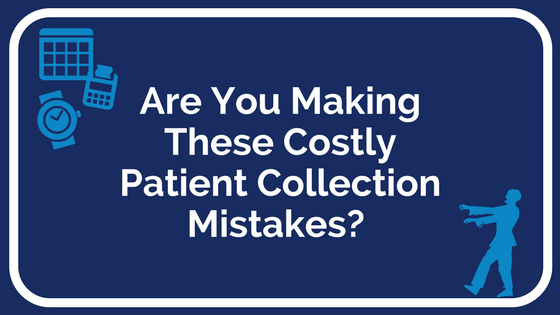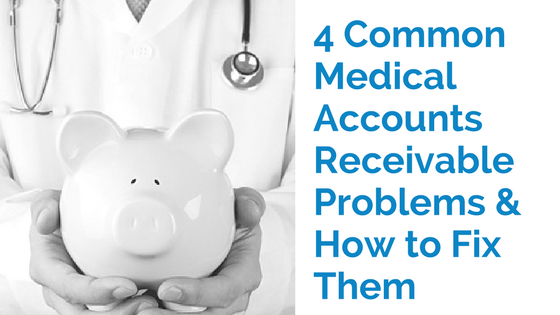Uncategorized

When attempting to collect from patients it is easy to make simple mistakes that could cost your practice money. Financial conversations can be stressful, and in order to make it as comfortable for the patient as possible representatives may be too accommodating and make arrangements that do not benefit the practice in order to maintain the patient relationship.
However, there are ways to address the patient’s needs and secure acceptable payments for your practice. In this article and video series we share some of the most common patient collection mistakes you could be making, and simple tips for avoiding them.
The $10 Payment Trap
When establishing a payment arrangement it is very easy to fall into the $5 and $10 payment trap. When you ask a patient, “How much can you put toward this balance today?” you will inevitably hear $5, $10, maybe even nothing at all. When asked this question patients are often considering what they have available at that moment, after all of their other bills have been paid.
Instead, phrase the question this way: “How short of the balance are you today?” In our experience this question is often met with much higher commitments because it forces patients to consider their entire balance, rather than what they want to put toward it at that moment.
Long-Term Payment Arrangements
Once a patient has agreed to a monthly payment on their balance it is tempting to accept any amount they are willing to pay just to establish a consistent payment schedule. What representatives and patients alike do not consider when working out a payment amount is the length of the arrangement being established.
Consider this: accepting an arrangement of $10/month on a $500 balance is agreeing to give the patient more than 4 years to pay their bill. When you point this out to the patient even they will probably agree that it is an unreasonable arrangement. Keep a calculator by your desk in order to quickly calculate the length of an agreement before committing to it to ensure that you do not enter into a payment arrangement that is not beneficial for your practice.
Waiting Too Long to Begin Collection Calls
The chance of recovering your balance in full after the time of service decreases by 50% as soon as your patient walks out the door and the cost to collect only increases over time. According to the American Collector’s Association, the average recovery rate after 180 days – when most practices begin collection efforts – is only 13%.
One of the most common mistakes in patient collections is waiting too long to begin the process. This does not mean sending delinquency notices within a few days of service. There are simpler steps you can follow to help the patient prepare for their responsibility that can lead to higher recovery and a better patient experience. Provide an estimate prior to services being rendered whenever possible, and be sure to discuss responsibility before, during, and shortly after the time of service. Don’t miss the opportunity to collect more for your practice by waiting until after the patient’s appointment to begin a dialogue with them about their responsibility.
For tips and best practices for collection more at every stage of the revenue cycle, download our patient collections eBook!
Holding on to Past Due Accounts Too Long
The cost to collect from your patients does not only increase for your practice over time. The age of an account also affects the costs for your third-party medical collection agency. Most agencies will charge a higher fee on older accounts to compensate for the additional time and resources required to collect them. For optimum recovery we suggest sending your accounts no later than 120 days after delinquency.
Regardless of the age you choose, your practice should make a decision when to send delinquent accounts to your agency, share that timeline with patients in your financial policy, and strictly adhere to it. In addition to collecting more of your past-due balances, your patients will gain an understanding of your policies and procedures and may be timelier with future payments. Consistent reporting to your collection agency will also help to improve their recovery and lower your costs for a much healthier revenue cycle.
Want to keep this information handy? We made you a printable guide. Click here for your copy.
Take this article with you! Click here for a printable version.
Written by Ali Bechtel, Digital Marketing Manager for RMP
This information is not intended to be legal advice and may not be used as legal advice. Legal advice must be tailored to the specific circumstances of each case. Every effort has been made to assure this information is up-to-date as of the date of publication. It is not intended to be a full and exhaustive explanation of the law in any area, nor should it be used to replace the advice of your own legal counsel.

Whether to credit report your patients’ overdue medical debt is a business decision that must be made by healthcare leadership in every organization, from single-provider practices to health systems. It can be a difficult one to make when your organization is in the business of providing care.Continue Reading The Business of Providing Care | FAQs about Credit Reporting Medical Debt

Are there consistent errors within your medical accounts receivable management processes that are restricting your organization’s cash flow? There are a few common problems that plague healthcare providers that can be avoided in a few simple steps.Continue Reading 4 Common Medical Accounts Receivable Problems & How To Fix Them



